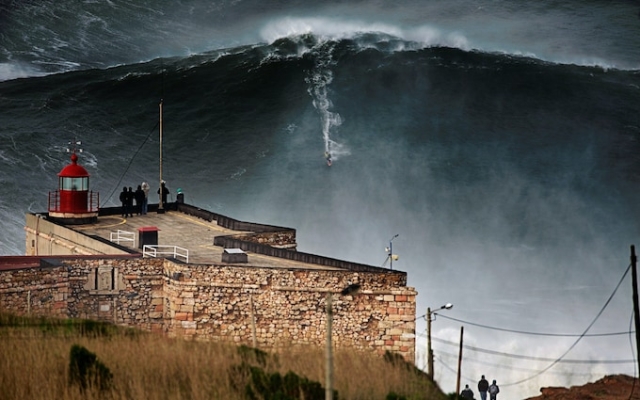 Record: McNamara on the wave in Nazaré
Record: McNamara on the wave in Nazaré
Unless you've been hit by a falling seven-story building, it's hard to imagine what it's like to crash into the world's biggest waves. After a certain height — say 30 feet — the waves stop behaving like water and become masonry. Charging their nearly vertical faces, surfers reach speeds of up to 50 miles per hour. When they crash, they bounce sickeningly across the surface, like a motorcyclist sliding on concrete. Bones break. The joints are turned out of place; one surfer even had his earlobe torn off by the force of the impact.
Big wave surfing is an extreme sport, a way of life and — for some of its adherents — something close to a religion. To handle the biggest waves on the planet, surfers cannot rely on muscle strength alone. Instead, they are towed by jet skis into the churning surf. The boards are also shorter, with leg straps so the surfer doesn't get knocked off their feet when they bounce off the face. And necessity has given birth to new inventions in the field of safety — most giant wave chasers wear helmets to minimize concussions and specially designed wetsuits with automatically inflating life jackets. Theoretically, they throw the surfer to the surface, even if he has passed out. However, «holds» of two minutes or more are not uncommon. Spend enough time on the break of a big wave and you will most likely see a limp figure hauled ashore, life thrown back into them by CPR.
This sport has its own places of pilgrimage. The current epicenter of the world stage is Nazare, a city about an hour north of Lisbon on Portugal's Atlantic coast. This is a small, rundown fishing port that was almost unknown as a surf spot ten years ago. Outside of the summer tourist season, he was dead. Restaurants are closed; hotels are closed for the winter. Even today there are no traffic lights in Nazar.
That all changed in 2011, when footage surfaced of Garrett McNamara, an American surfer, breaking a 78-foot wave off Cape Nazare. At the time, it was the largest wave ever surfed. The clip, which still seems like a miraculous, inhuman feat, went around the world. The publicity secured McNamara's career and made Nazaré famous. Today, it and the city are synonymous with extreme surfing and the unfulfilled dream of riding a 100-foot wave, the Everest of surfing.
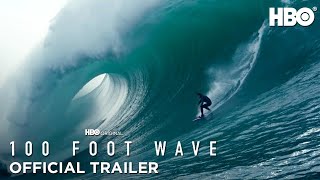
Obtaining an audience with the High Priest Nazaré is not easy. McNamara divides his time between Portugal and the northern coast of Hawaii, where he grew up, and the time zones are not in our favor. He is also heavily involved in promoting the second season of the Emmy Award-winning HBO documentary The 100 Foot Wave, which focuses on surfing in Nazaré.
Director Chris Smith, documentary filmmaker Jim & Andy (2017), on the surreal making of Andy Kaufman's biopic Man in the Moon, as well as the amazingly entertaining film Fire: The Greatest Party That Never Happened (2019), The 100 Foot Wave is an extremely gripping watch. The sea scenes are filmed with real visual brilliance by McNamara's longtime collaborator Mike Prickett, best known for iconic surf films Chasing the Mavericks and Step Into Liquid. Prickett, who is partially paralyzed by the bends while rescuing another surfer, the incident chronicled in 100 Foot Wave, pioneered the use of jet ski-mounted cameras and remote-controlled filming at Nazar.
However, the series is also captivating because of the intimacy with which it dives into the lives of the surfers that make up the Nazaré community. It is as much a portrait of this ersatz family—their triumphs, tensions, and tragedies—as it is of extraordinary athleticism. And although McNamara was quite a big name before the show, this helped him become a world star.
The first season revolved around McNamara, his family and friends after their attempts to open up Nazaré to the world. On the contrary, in the second season, the secret is revealed and the scope is expanded. He finds McNamara as a senior statesman and the focus is on the other surf personalities now gathering, winter after winter, at Nazar, hoping to set a world record.
“Why a second season? That's a great question!» McNamara says when I finally find him on Zoom. It's early morning in Hawaii, and his three young children are squealing with joy in the background, and his wife Nicole comes into the frame from time to time, joining in his thoughts. (He also has three children from a previous marriage.)
100 Foot Wave was originally written by Nicole as a 90-minute movie, McNamara explains, but when they sent three years of footage to HBO, they were told it was enough for 10 TV seasons. And yet Nicole was unhappy: «She wanted an Oscar, not an Emmy!»
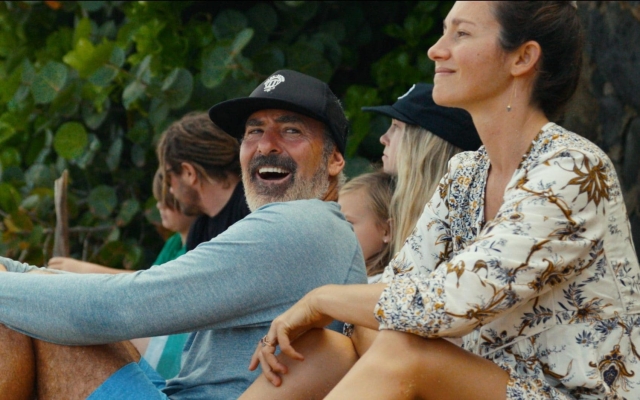 Family: McNamara, his wife Nicole and their children Photo: HBO/Warner Media
Family: McNamara, his wife Nicole and their children Photo: HBO/Warner Media
In conversation, McNamara looks as disarming as quicksilver. Anecdotes often end with rolling laughter and a wolf grin. But some questions I answer with a stare that makes me writhe 7,000 miles away. I get one when I ask about his reckless, stormy childhood. He and his younger brother Liam were raised between Guatemala, California and Hawaii by his mother and several men. Sometimes she left them altogether, and the boys took care of themselves.
“Well, I started at Berkeley right after the People's Park riots in 1968-1969,” McNamara recalls. “It was very liberal, very far-sighted, and we lived in a hippie commune in Cazadero. My mother just let us experience things and set us free. It was amazing.»
When he was 11 years old, they moved to the north coast of Hawaii. The scenery was idyllic, but the island was deeply divided along ethnic lines. Khaoles, as white immigrants were called, did not inspire confidence among the natives islanders; in turn, these new immigrants often responded with racism.As a child, McNamara found himself in the spotlight.
“On my first day of school, this guy pushed me. And in Hawaii, you can push a guy, but you're not going to fight him. I didn't understand it, so when he pushed me, I just knocked him out. I was the only white boy in the class, but after that I earned the respect of the entire school.”
Respect also came when McNamara and Liam began proving their mettle during breaks in Hawaii. There, too, they had to contend with racial politics, strong surf, and razor-sharp corals.
“If you happen to be in the wrong place or at the wrong time when some guy swims out, you should go inside. we will hit every day. But we were very lucky, just these little sand-colored blond kids who hung out with the [local] boys. If things get heavy, they will protect us. When I look back on my childhood, I think of freedom. And the ability to get along with anyone.”
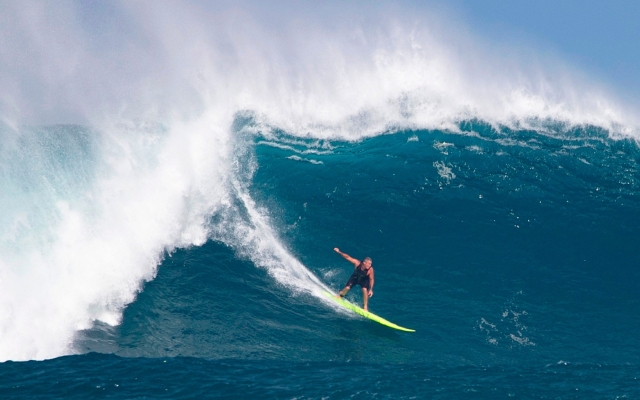 How it all began: McNamara surfs the Pipeline break in Hawaii 2019. Photo: BRIAN BIEHLMANN
How it all began: McNamara surfs the Pipeline break in Hawaii 2019. Photo: BRIAN BIEHLMANN
At 17, McNamara turned pro, competing in international surf competitions over the next decade. He had some success, but was largely eclipsed by his brother.
“In the 1990s, he was known, if known at all, as the younger and much quieter brother of Liam McNamara,” says surf writer Matt Warshaw, who has been watching for decades. “Liam got a lot of attention for being an energetic surfer and for being very edgy. Garrett was very much in the background at the time.”
As shown in the first season of The 100 Foot Wave, by age 30, McNamara was ready to pack him. He opened a surf shop in Hawaii. , and tried to settle into a life that didn't involve obsessively chasing storm waves around the world.
Did not work. Within a few years, despite the success of his business, McNamara became depressed and his marriage faltered. “Garrett was not at peace with himself,” says his wife Nicole at the start of The 100 Foot Wave.
In 2010, a letter arrived in his mailbox. He was invited to Nazaré by four Portuguese surf enthusiasts. Their bait was a video of a truly monstrous wave — completely empty. He flew to Portugal that winter and spent his first season in the place that made his name. He «discovered» Nazaré and made him his own.
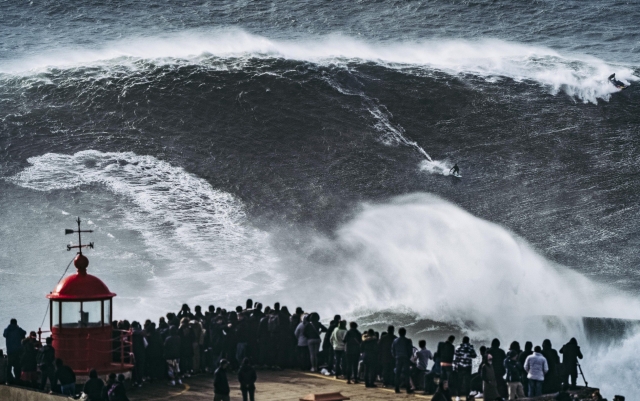 Viewers watch Nazaré's record-breaking rise. Photo: HBO/Warner Media
Viewers watch Nazaré's record-breaking rise. Photo: HBO/Warner Media
At least that's the underlying myth. In fact, Nazare's tourism board has long recognized its potential as the next big wave Mecca, and they've even organized bodyboarding competitions there. But they failed to attract international attention. So they switched strategy to courting an experienced big wave surfer before the break. McNamara was first on the list. However, they spent over a year trying to convince him to come. The biggest surf came with the winter storms — if they can make Nazaré a surf destination, that would mean year-round income.
When McNamara finally arrived, the enthusiastic Portuguese team did their best to help him catch the record-breaking wave. They provided lodging, jet skis, and even sent a hydrologist with McNamara to study the gap up close. They called their efforts Project Canyon.
Of course, Nazaré's fame is still largely — and rightly so — based on McNamara's world record. But some grumble that his feat overshadowed years of effort and energy of the locals. «It doesn't look like Garrett came here and found this,» said Paula Caldiera, one of the founding members of Team Nazare. “I know it's not good to kill a good story with the truth, but that's not how it actually happened. Of course, we never intended to ride such a big wave. Garrett has all the merit, but perhaps he was lucky that he answered [this] letter.
Like Formula 1, big wave surfing is an exciting mix of individual daring and challenging teamwork. Usually surfers work in pairs, taking turns towing each other onto the waves. But they also rely heavily on watch teams on the cliffs. These lookouts radio when they see a large group approaching, but also, very importantly, they help coordinate with the jet skis to pick up fallen surfers when they are incredibly small in the foam after the wave. Many of the most cherished spotters and water skiers are recruited from the original Portuguese Project Canyon team.
They get their name from the geological quirk that is the source of the colossal Nazaré wave. Not far from the cape of the city, the seabed drops almost vertically down 5,000 meters into an underwater canyon, the largest in Europe. This extreme elevation change is the engine of Nazare's waves: as the swell approaches the shore and the seabed becomes shallower, its enormous force is concentrated, reaching a crest just below the picturesque red fort of Nazare. (The fort is almost as famous as the waves, providing a useful vantage point for onlookers and an Instagram-friendly foreground for the most impactful shots, and is also the defining image of a 100-foot wave.) The two waves meet at the tip of the city's peninsula, creating chaos. mountain waves and white water crashing against jagged rock ledges.
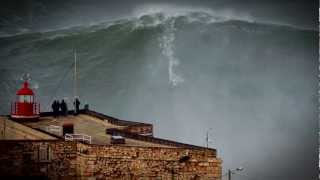
Unlike other giant waves, such as Jaws in Hawaii, which break on coral shallows far out to sea, viewers can experience Nazaré's waves almost as intuitively as surfers. On hard days, the city is noisy from the surf. Windows rattle. The door handles are shaking. An eerie hum echoes through every street. Al Manny, an Irish surfer who played a major role in the first season of The 100 Foot Wave, described being kept awake by the sound before going outside, as if he heard the clock ticking until his execution.
Nazaré was transformed by McNamara's innovation. In 10 years, it has gone from no winter season at all to being overcrowded — some would say overcrowded — all year round. In 2014, 40,000 people paid a one-euro admission ticket to go up to the roof of the fort and watch the action below; in the 2019-2020 season, this figure was 350 thousand. Big brands like Red Bull and Mercedes have set up warehouses in the harbor where fishermen used to dry their catch. And many of the best surfers in the world, including McNamara himself, own houses there.
But with the crowd comes aggression and accidents. Last season, fights broke out in the water between rival jet ski teams and a string of horrific injuries. Did McNamara ever want to keep a break to himself?
«No, I'm in a place where I can only afford to surf on perfect days,» he says. “[In 2011] I was hungry. I was on a mission to hit the biggest wave in the world so I could surf for the rest of my life. It was my passion, but also my job. And the main monkey on my back was financial security and the ability to provide for my family.
“Now I like to ride small waves. And I'm happy with how it went — the only thing I would do differently is make sure the infrastructure is set up properly before Nazaré becomes a hotspot. Everyone builds out of control. It's like they're taking shit everywhere. It's sad that he's overdeveloped in such an ugly way.»
He sighs, «But that's capitalism.»
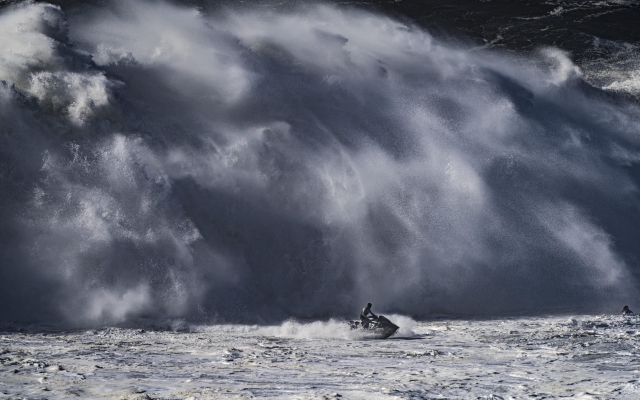 Jet ski drivers rescue falling surfers. Photo: HBO/Warner Media
Jet ski drivers rescue falling surfers. Photo: HBO/Warner Media
It's no coincidence that McNamara's career resurgence coincided with the advent of social media. He caught his 78-foot wave a year after launching Instagram and was one of the first and most successful surfers to build a personal brand based on shareable daring exploits. (The previous documentary series chronicled his efforts to become the first person to surf the trail of a breakaway glacier.) For some, McNamara has ruined the purity of his sport. Others point out that there is nothing new in the “athlete as an influencer” model. And besides, the life of a free-surf rat is fun for you at 20, but as decades and dependencies pile up, it starts to lose its charm.
“As surfers, we want to be humble. We don't like to talk about ourselves,» he muses. “That was the rule of growing up. I was lucky that one of my best friends in Hawaii, Lowell Hussey, was the senior vice president of Time Warner, and he said, «We have to show your face.» a ton of money. And that was before social media, before it was cool.
“Now everyone does it. And as an athlete, if you don't promote yourself, you're at the mercy of the companies you work for. But if you are not doing it for your job, not for your career, then you are wasting your life. I'd get rid of him tomorrow if I could.»
Warshaw credits McNamara as a pioneer in this regard. “Two of his biggest accomplishments are recasting himself at a relatively late age as a dedicated huge wave rider and excelling in terms of marketing and branding. I feel, with Garrett, that if we weren't watching, he wouldn't be doing it. Riding big waves and filming and talking about it later is his job, and he's very, very good at that job.»
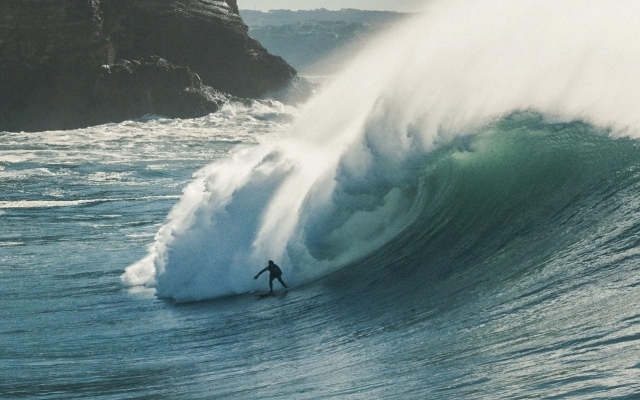 The second season of 100 Foot Wave is aimed at a wider range of surfers. Photo: HBO/Warner Media
The second season of 100 Foot Wave is aimed at a wider range of surfers. Photo: HBO/Warner Media
Of course, part of that job now is being the face of a 100 foot wave. And some in Nazar are ambivalent about the amount of attention the city has given to the series. One of them is local surfer Nick von Rupp. “There is a lot of tension as everyone wants to be famous, make money and be successful,” he said. “People want to get a piece, and if they don’t get it, they get angry. Sometimes it's crap.» Another surfer, Germany's Sebastian Steudtner, who currently holds the world record for the 86-foot wave caught off Nazaré in 2021, compared its crowded line-up to «a kindergarten class without a teacher.»
If this is a kindergarten, then it is unimaginably cruel. Steudtner missed most of the 2021-22 season after a leash wrapped around his ankle and tore it. Meanwhile, in 2013 Brazilian women's champion Maya Garbeira found herself under a wave. She lost consciousness and had to be resuscitated on the beach. She still suffers from post-traumatic stress after the incident. And at the beginning of this year, the first death occurred in Nazar. Marcio Freire, 47, fell off his board in a relatively small 20-foot wave. Observers lost sight of him, and he stayed under water for three waves in a row. Eventually, his partner on a jet ski managed to get him ashore, but he was pronounced dead at the scene.
McNamara has witnessed many of Nazaré's accidents. Indeed, as graphically shown by the 100-foot wave, he was a running mate on two of the worst. In 2017, one of his closest friends and Nazaré pioneer Andrew Cotton fell off his board in a 60-foot wave. Footage of the incident shows a British surfer jumping helplessly across its surface before being sucked into the white water. He broke his back and was treated for a year. And last year, McNamara towed his son-in-law, CJ Macias, into a giant southpaw. Cutting his face, Macias plunged too far into the chute, where he was swallowed up by the breaking wave. He broke his shoulder and ended up paddling frantically with one arm, trying to keep his face above the water. Nicole watched from a cliff as her husband fought for her brother's life.
«Do I feel responsible?» McNamara says. “I feel 100% responsible for the person you put on the wave. But once you let go of the rope, you are on your own.
“With Cotty, he decided to go deeper – he wanted to hit the barrel, and that’s when the accident happened. With CJ he picked an amazing line and almost made it. It would be incredible. I feel more like a facilitator, a facilitator, and along the way you might run into… some major issues as we move this forward these days.”
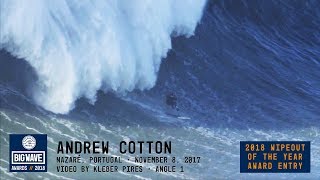
Nicole leaves the room and I ask the question that has been haunting me since the beginning of our conversation: is he afraid to die?
Suddenly, he's upbeat again, a young Hawaiian daredevil ready to take on the world. “I don't like to bet against myself. I don't have health insurance. I don't have life insurance. I eat healthy. I will live!»
Age is an unspoken factor in McNamara's career. He is almost 56 and while there are professional athletes who are still strong at the same age, extreme surfing is a brutal sport. When will he know it's time to end?
“Retirement doesn’t seem to exist at this stage,” he says. “My current goal is to be in the best shape of my life, so when the ideal conditions come, I will be ready.”
For now, this regime includes a 21-day detox diet with raw soup: “I will lose 10-20 pounds and become thin as a surf machine. I don’t even feel hungry,” as well as daily meditation and exercise.
However, I have the impression that the pursuit of records has weakened, if not completely died out. Measuring big waves is subjective, somewhat arbitrary, and McNamara is caustic: “It's pretty stupid. At some point, they measured the bones of the lower leg, and no one ever measured mine, so I'm sure they actually walked … ”(Of course, it’s easier to be optimistic about such things when you have built a successful career on the flip side of a world record.
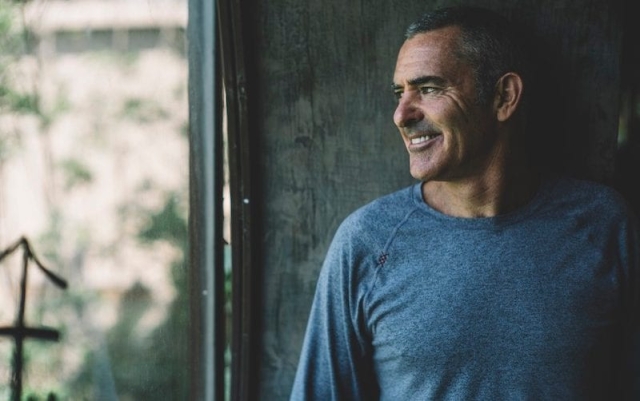 «Retirement doesn't exist at this stage»: McNamara doesn't want to slow down. Credit: jason reposar
«Retirement doesn't exist at this stage»: McNamara doesn't want to slow down. Credit: jason reposar
However, McNamara's greatest legacy may be out of the water. He helped transform Nazaré from a deserted seaside town into the linchpin of a worldwide big-wave circus that has since been solidified by the HBO series. But just as important, he forged a new way of being as a surfer. Thanks to him, at least among professionals, the laid-back tumbleweed personality was all but banished. Indeed, most surfers today are as stubborn in business as they are in the water. In less than a decade, McNamara has remade the sport in his own image. As Warshaw says, “The future of commercial big wave surfing will be based on what Garrett has done over the past 20 years. For better or for worse.
McNamara is currently eyeing a feature film based on his life. There are several celebrities sniffing around for the project, including How I Met Your Mother's Jason Segel. “He could write it. But I don't know if it's dark enough because I want it to focus on my childhood and surf a bit. Take a look at how gross it was and show it works. That you can't be a victim. You cannot let your past define you.»
But what is holding him back now?
“Some people do it for the sake of work, and others just because they like it. But I think ego has a lot to do with it. The ego needs to be fed.»
He stops, recovers — and again this smirk. «No, the ego loves to be fed.»
Then it softens. “You are either a little kid who really wants to do it. Or you are a small child who does not want to do this. I was a little kid who had my ass forced on me and I never wanted to do that. But I worked my way up, facing my fears, planning…
He trails off. And he tries once again to explain what surfing means to him. “It's a desire, a passion. This is more than life. It's like just a beautiful dance with nature. It's like… I don't know, you're dancing with God.»
The 100-foot wave is now in Sky and Max documentaries

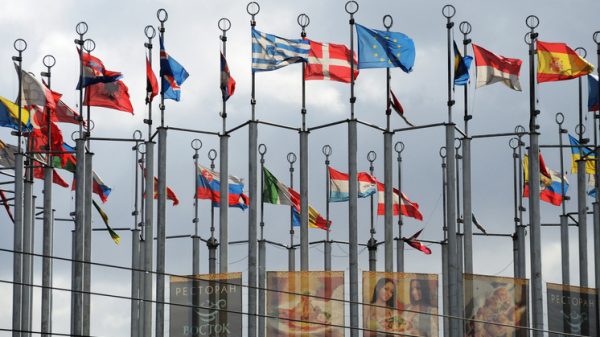
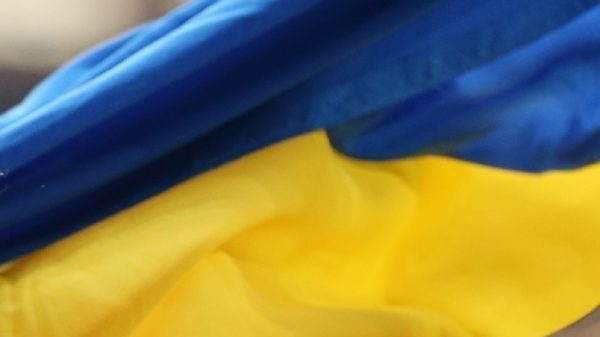
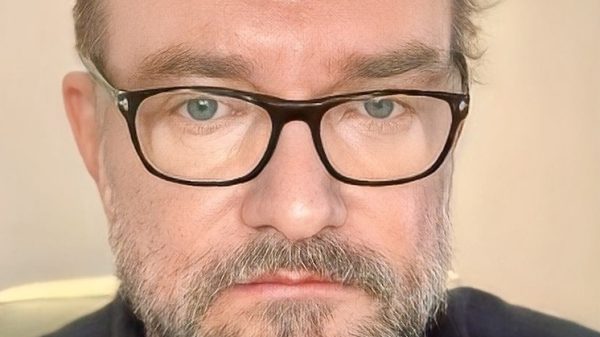






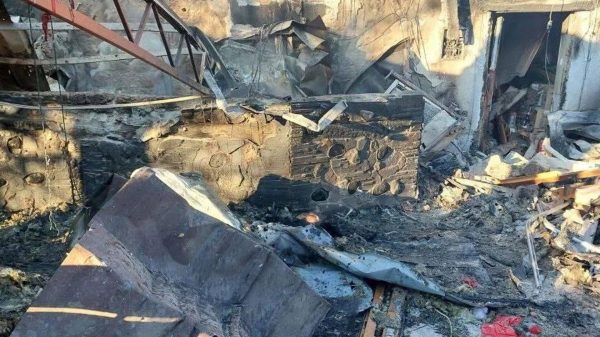

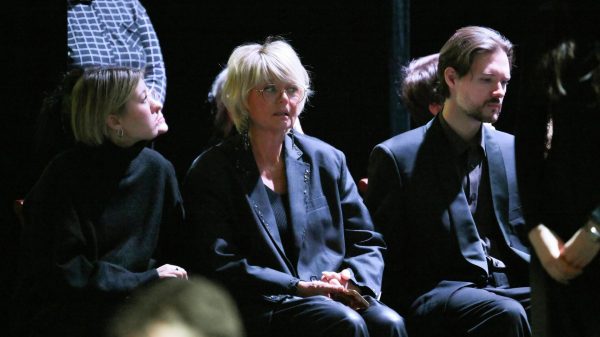
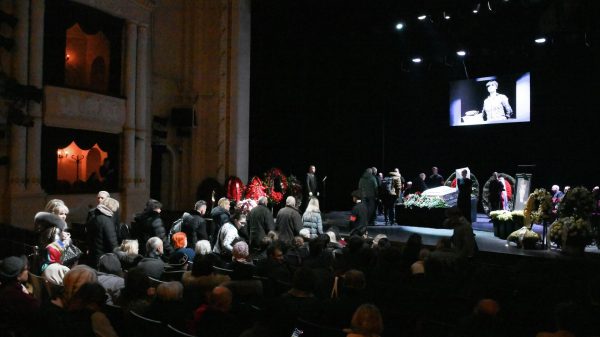

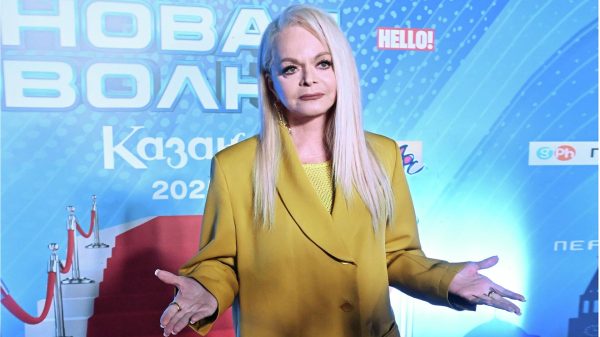





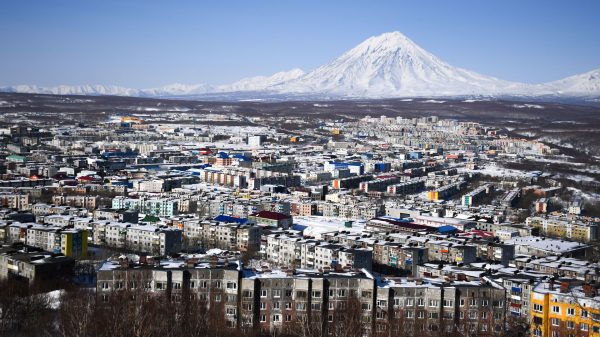

































Свежие комментарии